



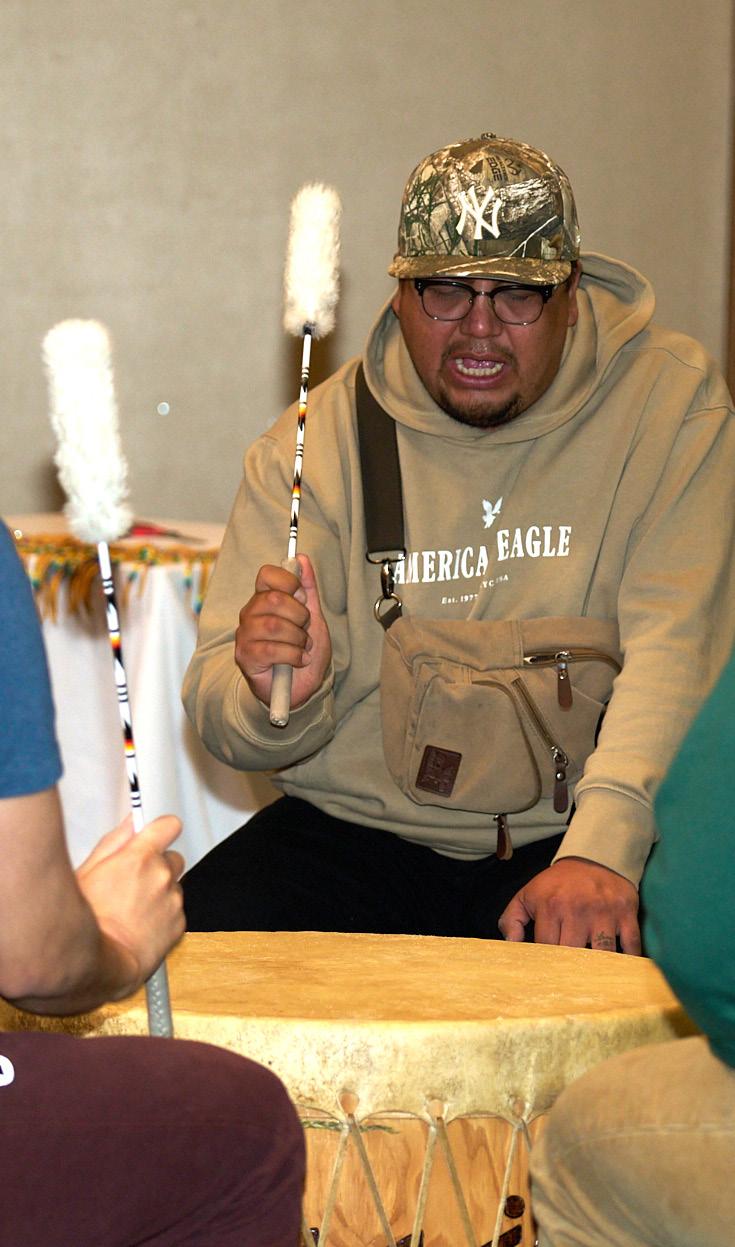






















by Will Nicholls
Steven Crowchild, a council member of the Tsuut’ina Nation west of Calgary, had what he called an intense discussion with US President Donald Trump on the tarmac. Even before Trump arrived for the G7 Summit June 1,
At another summit hosted by Doug Ford, the Ontario Premier apparently said First Nations like the gold but that they “can’t just keep coming hat in hand all the time to the government.” This was at an event on the eve of the summit to which he had invited several chiefs. The

Maybe there is hope someplace somewhere. Maybe our new federal government? Well, the new Carney administration seems to be having birthing issues. The biggest is the impact of Bill C-5 on First Nations. It’s a mirror image of a new Ford law to help fast-track mining of promo items experience with certified PPPC suppliers

of service in Eeyou Istchee


by Natalia Fedosieieva
by Xavier Kataquapit

(Top) Youth Led Protest Against Bill 5 participants were supported by First Nation and local leaders.
(Right) Elder Margaret Okimaw of Attawapiskat took part in the Youth Led Protest Against Bill 5 in Timmins on June 6.


First Nations youth took to the streets of Timmins June 6 to protest the adoption of Bill 5 by the Ontario government.
The so-called Protect Ontario by Unleashing our Economy Act aims to fast-track resource development in the Ring of Fire region around western James Bay.
“This is an important event for me to take part in because this government action will affect my future and the land, the water and the animals,” said co-organizer Leon Prince, from Mattagami First Nation. “Their decisions will bypass laws, our peoples’ rights and directly affect our lives.”
The law reduces regulations for infrastructure, mining and resource projects by allowing the government to bypass environmental, ecological and First Nation rights.
According to the Chiefs of Ontario, Bill 5 significantly weakens oversight of mining and development projects, and limits First Nations consultation and consent.
“I was honoured to take part in this youth-led event,” said Mattagami Chief Jennifer Constant. “It was inspiring to see youth from our community and from throughout the North take such direct action to protect our lands, our communities and our rights.”
Constant added, “I’m hopeful that the government will reconsider what they’ve tried to push through and for them to recognize that they have fractured the trust that was being built between the provincial government and industry and First Nations communities and First Nations people.”
The demonstration was organized by First Nation youths Shem Mattinas, Katherine Jeremiah-Génier, Kendrick Jeremiah and Leon Prince.
The march by protestors to city hall was originally planned to be a small sidewalk event. But police shut down the city’s main thoroughfare in front of city hall as the crowd grew larger than expected.


Department of Commerce and Industry

Prayers and ceremonies were led by Elders Angela Shisheesh, Morris Naveau, Margaret Okimaw and others. It included traditional drumming and singing by local performers, as well as participants attending in traditional regalia and performing on ceremonial hand drums.
“I am here to support the youth of our communities,” commented Mattagami Elder Naveau. “It is great to see our young people here today. We have to stand strong to support our youth, our land, our rights and for our Mother Earth.”
The event brought together numerous speakers and supporters, including Deputy Grand Chief Mike Metatawabin (Nishnawbe Aski Nation), Deputy Grand Chief Natasha Martin (Mushkegowuk Council), Chief Elizabeth Kataquapit (Fort Albany FN), Timmins mayor Michelle Boileau, and former Timmins MP Charlie Angus. It also attracted supporters from the city and from the First Nations of Fort Albany, Kashechewan, Attawapiskat, Flying Post and Mattagami.


state of emergency over a community water crisis in Chisasibi was lifted after potable water was restored June 6. Tests confirmed that water was safe for consumption, although the reservoir was not yet at full capacity.
The emergency was declared when a lightning strike damaged the water treatment plant on June 3. Workers saw a flash of light, then smoke coming from control panels. Chief Daisy House knew something was wrong when she saw Barry Bearskin, the community’s director general of operations, when she went for coffee that morning.
“I’d never seen his face look so down,” Chief House recalled. “There were so many unknowns. We had just finished our plant in the fall and were still using the old one. At 11:35am, we declared a state of emergency because we wanted to make sure we had potable water, that was the number one thing.”
Chisasibi leaders thanked local workers for their dedication.
“We witnessed your hard work around the clock, often under challenging conditions, and we are truly grateful for your efforts,” shared the Cree Nation of Chisasibi. “Situations like this highlight how vital it is to have a team like ours, ready to respond when our community needs it most.”
Chisasibi was already suffering a water shortage due to abnormally low levels in La Grande River. A boil-water advisory was issued June 2, before a complete system shutdown came later that day. HydroQuébec had been contacted to release more water from upstream dams.
La Grande is the second longest river in the province, flowing about 900 km to James Bay, extensively developed by Hydro-Québec. Among the eight dams in Chisasibi territory, the LG-1 generating station is about 30 minutes from the community and the LG-2 about an hour upstream.

by Patrick Quinn, Local Journalism
With sediment and organic matter clogging the community’s water intake, CNG engineers and other water experts worked to install floating pumps to bypass the issue. Unfortunately, a fuse on one of the pumps wasn’t working and another cable was too short, so missing parts had to be ordered.
Facing critically low water levels in the community reservoir, the supply was briefly returned intermittently before being closed again to conserve remaining resources. Air Creebec, the Cree Construction and Development Company and food wholesalers helped deliver bottled water beginning June 3.
Residents were urged to limit non-essential usage while tubs of river water were made available on the shoreline for flushing toilets. All schools and daycare centres were closed until further notice.
“It was like one thing after another, but we still had high hopes,” explained Chief House. “Everybody was so understanding, patient and cooperative. We know how to live without running water at our camps already. There are a lot of overcrowded homes, and we didn’t want to overburden the healthcare system.”
As hemodialysis treatment is impossible without water, patients were flown to Montreal. The Chisasibi dialysis team worked with the Montreal General
Community members were regularly updated about the evolving situation through radio announcements, social media posts and the Chisasibi app, which filters messages to various groups.
By June 6, the water station crew had removed filters to clear river debris. Sampling of the restored supply was conducted the following day before the state of emergency was lifted. Water treatment technicians worked tirelessly throughout the crisis – one worked 29 hours straight.
“Environmental factors forced us to intervene to fix the problems temporarily,” said Kyle Sam. “A mid-term solution will be implemented in coming weeks, the next part of the upgrade. Things are heading in the right direction. In a sense, I’m trying to drive a Ferrari without full throttle – engine is complete but need the tires.”
Praising the efforts of Bearskin and CNG water quality coordinator Laurence Truong, Sam said there is high demand for water technicians, especially with many in Eeyou Istchee nearing retirement. While transitioning to the new treatment plant, Sam said they had used the same intake pit in the old building.
“Now they have to install the chamber grid and a new water pit for the
While some suggest a pipeline or wave break, resident Roger Orr favours a water tower. Capable of storing over a million gallons of drinking water, these towers use gravity-driven hydrostatic pressure to guarantee a stable supply. Orr joked tht Chisasibi’s tower could say “Skoden”, like one was once spray-painted in Timmins.
Although the kitchen at Orr’s Retro Daze Café needs lots of water, he said he is is crisis-proof because he’s always used spring water for coffee and tea because of the water uncertainty over the last 20 years, noting the river’s levels have dropped substantially.
Many expressed relief that there were no fires during the water emergency, though the community’s dump had burned the week before and a health board unit burned the following week. Recalling the panic that spread in 2018 after a false rumour that a nearby dam had broken, Orr asserted that the community needs a backup solution for emergencies.
“We need sirens, with only a few individuals allowed to sound the alarm if something’s going on up the river,” said Orr. “Imagine if it was real. When a crisis

In December 2024, the Eenou-Eeyou Community Foundation proudly announced the Eeyou-Eenou Chiskutamaachewin Scholarship Program, in partnership with the Cree School Board. This initiative is designed to inspire and support Cree students in pursuing careers that are critically needed in Eeyou Istchee – medicine, nursing, social work, and education.
At 27 years old, Lyric Oblin-Moses already has so much to be proud of: a Bachelors of Science from the University of Ottawa; a Masters of Public Health from the University of Toronto; the love and support of her fiancé, Jacob, who she’s set to wed this summer; and, a beautiful baby girl, who she carried and gave birth to while in grad school.
But it doesn’t stop there.
In September 2024, Lyric began the journey to pursue her long-time educational goal of going to med school. “I spent so long contemplating applying and not going for it. It took me a few years to build that confidence. There was nobody else that was really holding me back except for myself,” Lyric explained. “I remember thinking to myself, ‘I should at least give it a shot; I feel like I owe it to myself.’
This was a dream of mine, something that I really wanted to do for a long time.”
While growing up in Waswanipi, Lyric gained a passion for learning that she credits to her family and teachers. In particular, she fell in love with math and science. But because advanced classes – such as physics, chemistry, biology – were not made available in her community, her family moved to Gatineau. While she attended high school there, her parents, aunt, and uncle attended college and university, which motivated her as a student: “I got to see first-hand the work it takes to study in university. It left an impression on me, showing me that it was within my reach.”
Her chosen field of study didn’t only fit because of her favourite subjects, but because her future profession aligned with her values, interests, and passions. “My drive is to contribute back to the community in some way. For me, medicine felt like the right path,” Lyric explained. “We know there’s an underrepresentation of Cree people in the medical field, and we need Cree Youth to pursue healthcare related fields. I’m going into this with the intention of practicing in Eeyou Istchee.”
When the conversation shifted to the challenges that come with living in the south, Lyric shared that she felt emotional thinking about it. “Moving so far away from home –from our culture, our language, our extended family – was one of the hardest things that we had to reflect on,” she stressed. The immense decision to attend post-secondary far away from home isn’t a hardship she bears alone. “Making the move to study in Ottawa, we’re making that sacrifice as a family.”
Another constant burden she acknowledges is the presence of racism – both overt and covert – as a student living and studying in the city. “We’re coming into spaces that are very western and institutional. I would even say these spaces originally weren’t meant for Indigenous people. It really wasn’t that long ago when policy determined we weren’t allowed to be doctors, we weren’t allowed to be lawyers.” Even though barriers still exist, Lyric strongly believes that change for the better is currently underway.

When she received the Eeyou-Eenou Chiskutamaachewin Scholarship, Lyric was pleasantly surprised:
“I consider the Foundation to be a representation of community, so receiving the scholarship is very meaningful.”
With this extra support, she and Jacob were able to better plan quality time together as a family. “For me, the time I have right now is really important. Once I’m in the hospital, I’ll have even less time,” Lyric predicted. “The scholarship was a huge, huge support. We were able to do things as a family during the Christmas break and offer experiences to our daughter.”
I asked Lyric what advice she would share with Cree Youth who may be contemplating med school. In a way, this question allows her to speak to her younger self – the little girl from Waswanipi. “Remember not to be so hard on yourself because it’s not easy. Remember that you have a community who’s cheering you on. And always remember you have support.”
Story and photo by: Karen Joyner-Blom, Director of Communications and Community Outreach,Eenou-Eeyou Community Foundation
We extend our heartfelt thanks to Power Corporation of Canada for making this scholarship possible for the 2024-25 academic year. Chiniskumitin!
Read more about Eeyouch/Eenouch whose lives have been touched by the work of the Foundation: www.creefoundation.ca/stories
As part of the 49th Waswanipi Day celebrations June 10, the community broke ground on the future site of its new hotel, an important project that has been talked about since the early 1990s.
“That will be an opportunity for us to showcase Waswanipi and what we can provide,” said Marcel Happyjack, head of Waswanipi Development Corporation. “We’re looking forward to providing employment opportunities for local people to be part of something that we built.”
The hotel will be located next to Highway 13, where it can be easily seen by travellers. It will feature 20 guest rooms, a restaurant, a museum and a laundromat. With Waswanipi regularly hosting
various meetings, hockey tournaments and fishing derbies, finding accommodation for outof-towners has been difficult.
Although negotiations with contractors are ongoing, the community hopes to open the hotel in 2026. After many delays due to limited funding, the $12 million project will be supported by Waswanipi, the Cree Nation Government, the Quebec government and other partners.
In his first year playing professional hockey, Mistissini’s Israel Mianscum celebrated his team’s Eastern Collegiate Hockey League (ECHL) championship in Trois-Rivières June 8. The 22-year-old NHL prospect was recovering from a major knee injury this year.

“What a feeling to win with this group,” shared Mianscum. “It was a lot of ups and downs, from getting injured and not being able to walk for months to coming back and winning it all with this group. I learned that things can be taken away from you very fast, so embrace every moment you have and stay in the moment.”
After being signed by the Montreal Canadiens organization last year, Mianscum had hoped to join its Laval Rocket farm club in the American Hockey League. Instead, he joined the Trois-Rivières Lions in the ECHL, another professional league that serves as a stepping stone to the big league.
Over 57 games this season, Mianscum notched seven goals and 11 assists. The Lions triumphed in Game 5 of the championships with a 4-1 win over the Ohio-based Toledo Walleye to win the Kelly Cup. His family travelled for hours to experience the victory.
“You grow up watching the Stanley Cups or big games like that and just to be a part of it was crazy,” Mianscum told the CBC. “The best way to describe it was it felt like a movie.”
Leaders warn
First Nations leaders gathered on Parliament Hill to protest Ottawa’s controversial major projects legislation, Bill C-5, the One Canadian Economy Act. The legislation would allow the federal government to override certain laws for major projects, including the Indian Act and the Species at Risk Act.
Former federal justice minister and attorney general Jody Wilson-Raybould said that Indigenous peoples need to come together and “draw
a firm line in the sand” to kill Bill C-5. She said First Nations are “not fooled by the fancy rhetoric that we’re hearing from government ministers” about securing free, prior and informed consent.
The Assembly of First Nations hosted a virtual forum June 17 to discuss the concerns leaders have about fast-tracking projects of so-called “national interest.” AFN National Chief Cindy Woodhouse Nepinak said First Nations had only seven days to respond to an outline of the bill.
With just two days allocated for committee hearings on Bill C-5, Woodhouse Nepinak was the only Indigenous leader permitted to speak. A dozen chiefs sat silently behind her in the committee room. Abram Benedict of the Chiefs of Ontario, who had been invited to testify but was later removed, accused Ottawa of deliberately suppressing opposition.
The government was pushing to pass the bill using closure, an expedited process that would leave parliamentarians with less time to study and debate it. Indigenous leaders warned a legal battle could result if their rights are not respected, with widespread protests possible.
Indigenous Services Minister Mandy Gull-Masty said Bill C-5 does not “do away with impact assessments” and there are “multiple points” where First Nations and other groups can address their concerns. She has asked Prime Minister Mark Carney to screen new federal bills for their impacts on Indigenous communities.
“I hear what’s going on in the community,” said GullMasty. “But getting to the table and clarifying what your concerns are, that’s where the real problem-solving is.”

by Patrick Quinn, Local Journalism Initiative Reporter
Candidates for Grand Chief and Deputy Grand Chief have released their campaign platforms for Cree Nation Government elections on July 17. Voters need to be Cree beneficiaries of the JBNQA and at least 18 years old on the date of election.
There are three candidates for Grand Chief: incumbent Norman A.
Wapachee, John Kitchen and Paul John Murdoch. The five candidates for Deputy Grand Chief are Grace Darlene Cheechoo, Robin Gull Saganash, Sammy Salt-Blacksmith, Linden Spencer and John Henry Wapachee.
According to chief returning officer Robin Pachanos, poll stations will be open from 9am to 7pm on voting
day. Advance polls will open online July 13 at 9am and close on July 16 at 2pm. Voters accessing the online platform will be required to submit their JBNQA beneficiary number, date of birth and community of affiliation.
The Nation spoke with the three candidates about their experience, motivations for running and campaign priorities

Admitting that he was relatively unknown when running for Deputy Grand Chief four years ago, Norman A. Wapachee’s message “let us give our land a voice” resonated with Cree people. He worked well in a supporting role with Grand Chief Mandy Gull-Masty until she resigned in March to successfully run as a Liberal in the federal election.
With the opportunity to implement his own vision, Wapachee anticipates enacting the Declaration on the Rights and Responsibilities in Eeyou Istchee, which Council adopted in May. Giving land a voice, this affirmation asserts a responsibility to the land’s sustainability by incorporating customary practices in the modern context.
“The JBNQA will never address over-harvesting of moose on the Cree side,” Wapachee offered as an example. “If you incorporate our traditional laws, you only take what you need. There needs to be harmony – our ancestors did a damn good job taking care of the land.”
Wapachee shares a common sentiment that the CNG is too close with Quebec and disconnected from local realities. He said he advised Gull-Masty
to pull away from the province to work more closely with band Chiefs. He intends to restructure its governance to more effectively represent the communities.
Regarding potential projects like wind energy, he would closely collaborate with Chiefs to determine a common objective. Wapachee is proud of his work to establish a National Marine Conservation Area in James Bay, and believes a new regional research insti-
tute would encourage greater Cree involvement in protected areas.
Wapachee wants to create more opportunities for educated youth to come home. Reflecting on disturbing social issues witnessed in communities, he feels the responsibility to help develop holistic solutions that address “deeply rooted” impacts of colonialism.
“We must find ways of restoring that balance,” said Wapachee. “I talk to my grandson in Cree and he doesn’t understand me. Planting a seed for them to grow means a lot to me.”
A three-time former Chief of Waswanipi after a decade as band councillor, John Kitchen also has over 20 years of experience leading various construction and forestry companies. As president of Kuikuhaacheu Inc., his vision is to train and employ youth in resource-development positions.
Friends of Kitchen’s late son Joey Blacksmith said Joey would tell them, “One day my dad is going to be Grand Chief.” Moved by stories of tallymen witnessing the destruction of their traplines, Kitchen says his campaign will support tallymen in their demands for better rights and communication.
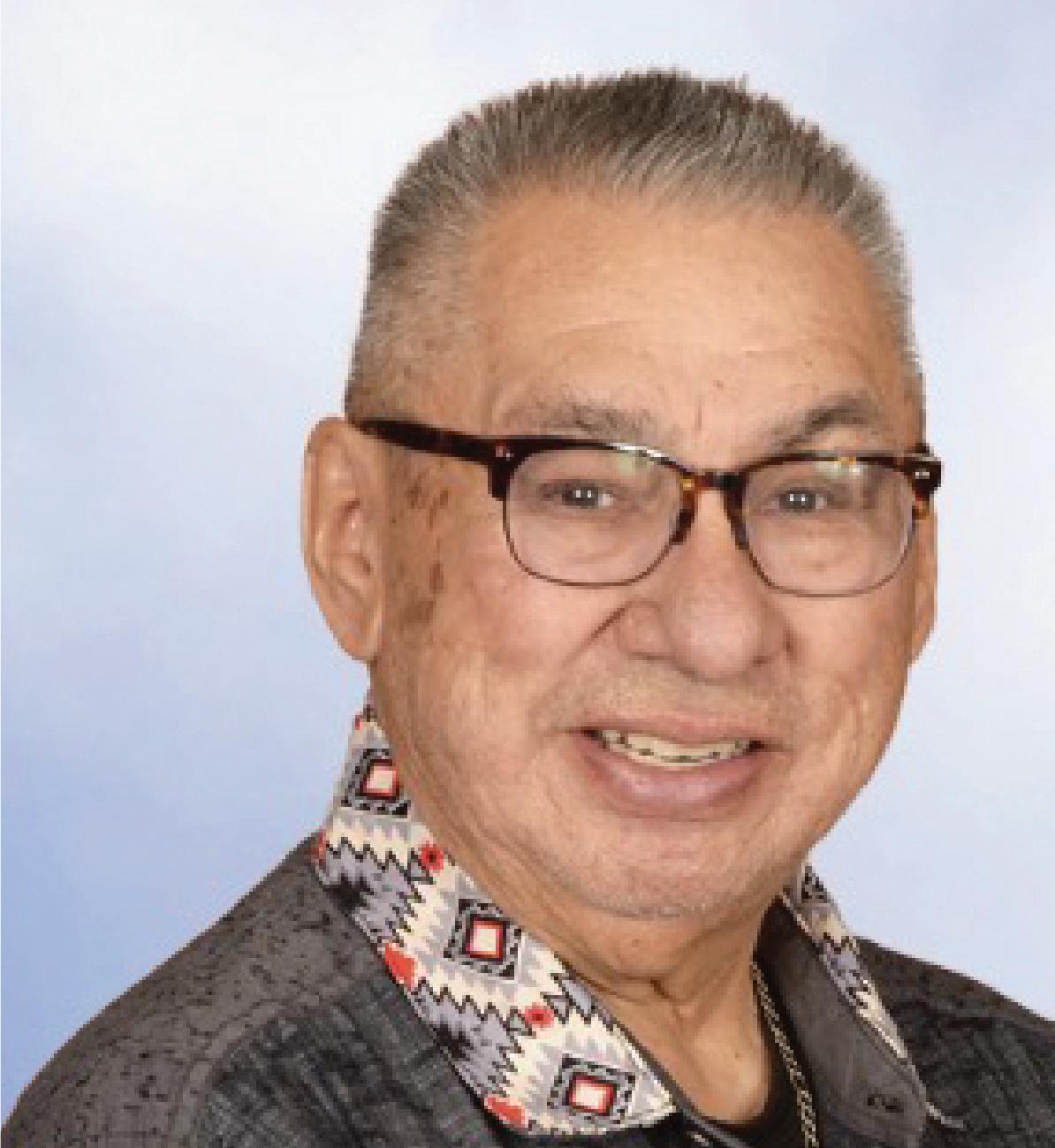

“I see industry and mining coming into our territory and doing what they want without really consulting the tallyman on their traplines,” said Kitchen. “They run businesses like they own the land. We have to get our land back and have a say.”
Kitchen believes land users should decide whether projects like railroads or pipelines pass through their territory while also benefiting from employment opportunities. Suggesting forestry companies mainly hire their friends, he asserted that local entrepreneurs should have priority.
As a residential school survivor, Kitchen sees today’s youth struggling with abusive patterns he’s experienced. He proposes local treatment centres and land-based programs, so youth don’t have to leave the region. With decreasing numbers in the income security program that supports traditional lifestyles, Kitchen proposes expanding Cree Trappers’ Association programs.
“We need to find alternatives for communities to build quality houses, again supporting local entrepreneurs,” Kitchen asserted. “Let’s create rentto-own houses. We should promote women in the workforce, youth too. We can work together and stand together.”
Paul John Murdoch’s campaign slogan “Eeyou Istchee strong and united” was inspired by his recent cross-country motorcycle trip visiting Indigenous communities. He had hoped to meet Chief Clarence Louie of the Osoyoos First Nation, a big admirer of Murdoch’s late uncle Billy Diamond.
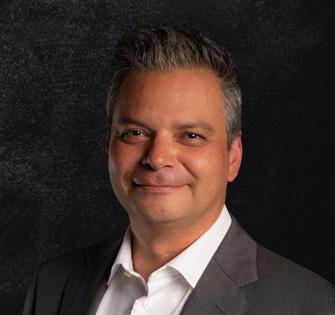
“When I visited Osoyoos, seeing all these young people having amazing jobs, I said that’s the direction we need to go in,” said Murdoch. “They have private companies investing in their community. That’s outside money building infrastructure – associated jobs are on the reserve.”
Murdoch suggested working with banks could trigger a housing boom. By bringing Cree economies together and defending local entrepreneurs, he believes employment and housing access will improve community safety. Enabling communities to address municipal violations would free the court system to deal with serious crimes.
As the first Cree member of the Quebec Bar, Murdoch said he’d give up his legal practice if elected to avoid potential conflicts of interest. Emphasizing his commitment to
accountability and transparency, he proposed clear processes for Grand Chiefs to divest themselves of economic interests and be subjected to a non-confidence vote.
Proposing an access-to-information act for journalists and the public, Murdoch said any correspondence with the Grand Chief should be shared with other leadership. He’s inspired by a handwritten document of the Grand Council’s founding Chiefs stating their mandate must come from the people and the communities, not the other way around.
“That is a founding constitutional principle,” Murdoch explained. “Over the years, it’s been a little too top-down sometimes. There’s no way to build trust if we have secrets from one another. We have the tools – we just need to work together to use them in the right way.”

July 13, 14, 15, 16, 2025
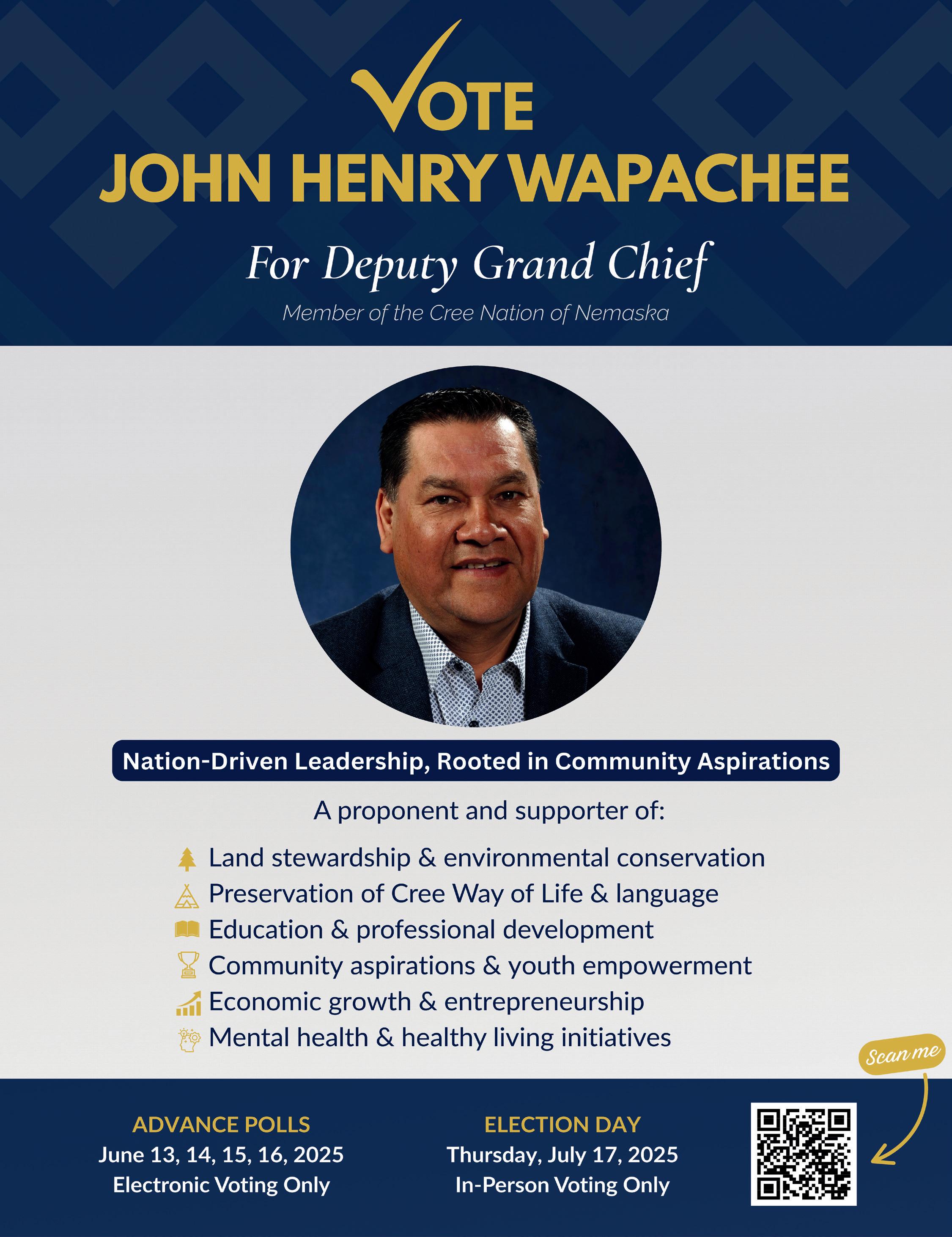




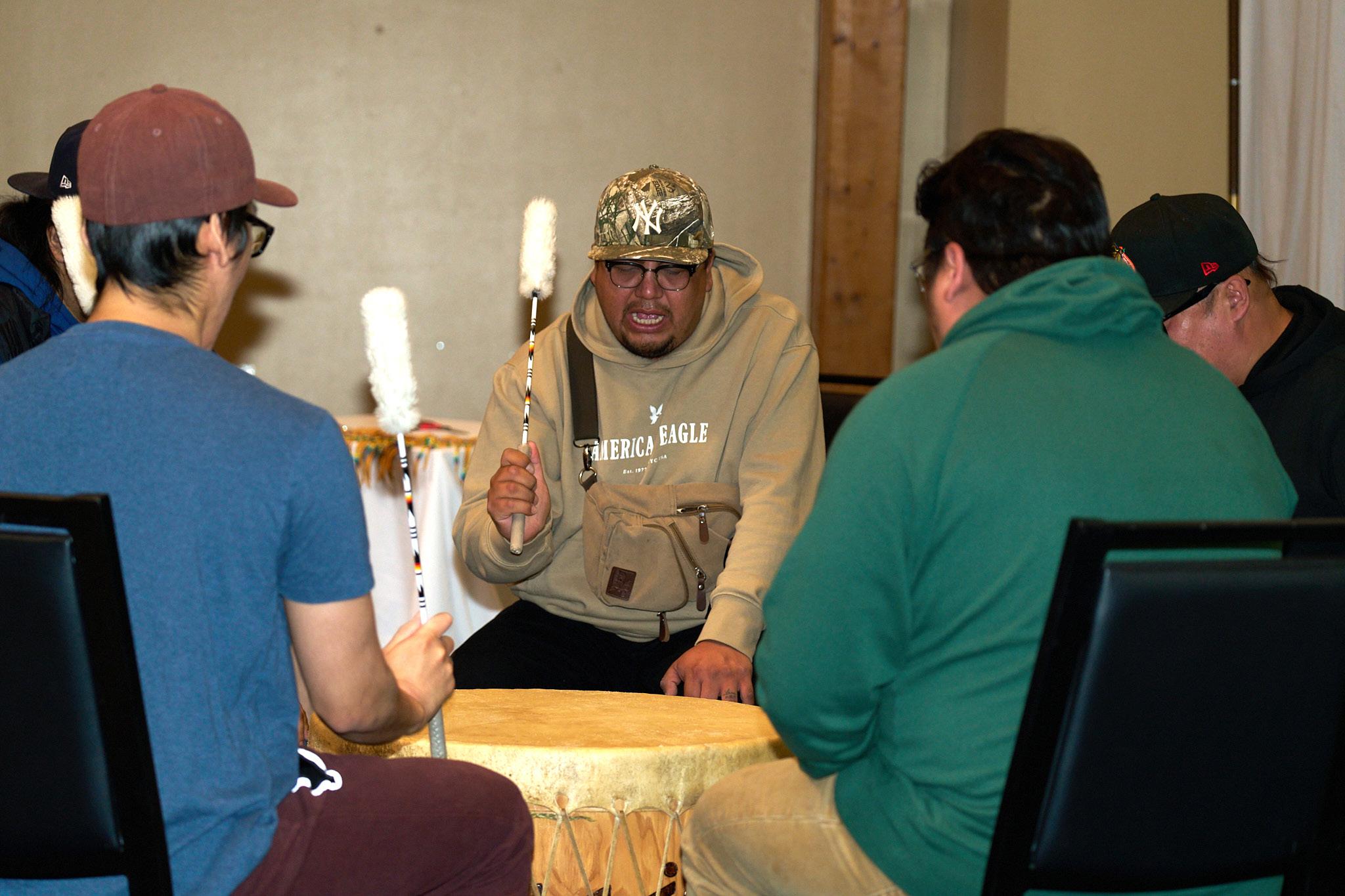
by Patrick Quinn, Local Journalism Initiative Reporter
On June 16, Chisasibi inaugurated the Eeyou Istchee College of Science and Technology. Founded on principles that prioritize Indigenous culture and language, the not-for-profit institution represents a historic milestone in the region’s higher education.
While the Cree School Board offers some springboard and online college and university programs through partnerships with McGill University, John Abbott College and Cégep de St-Félicien, this community-driven initiative is the first independent Indigenous college in the province.
Chisasibi’s plans for a college started to take shape after a series of round-table discussions beginning in 2018. High graduation rates in Kelly Petawabano’s early childhood education program provided evidence that in-community programs could deliver successful outcomes. Although the CSB isn’t involved in this initiative, Chief Daisy House suggested that future collaboration was likely.
“We did tell the school board about our plans and said let’s just do it,” explained Chief House. “The best part of this is we get to tailor it to our community. If people want to go down south,
the doors are always open – it’s providing options to our people.”
Despite population growth, House says the number of post-secondary students has remained in the 500-plus range for many years. Recalling that she didn’t even know where Gatineau was when she left for college 35 years ago, House empathizes the culture shock and homesickness that Cree students often experience in the south.
“The year my eldest son graduated in 2021, there were a record 71 graduates in Chisasibi and he was the only one who left,” said House. “He came home after two-and-a-half years and said, ‘I don’t want to go back.’ I don’t blame them for not wanting to leave – at 17 years old, moving 15 hours away to the nearest English CEGEP?”
After Chief House struck a committee to conduct feasibility studies between 2020 and 2022, former McGill University associate dean Carmen Sicilia was named college director. As Sicilia had previously worked with the community through McGill, focus groups and next steps came together quickly.
“I actually took my retirement, and the Chief reached out and said now

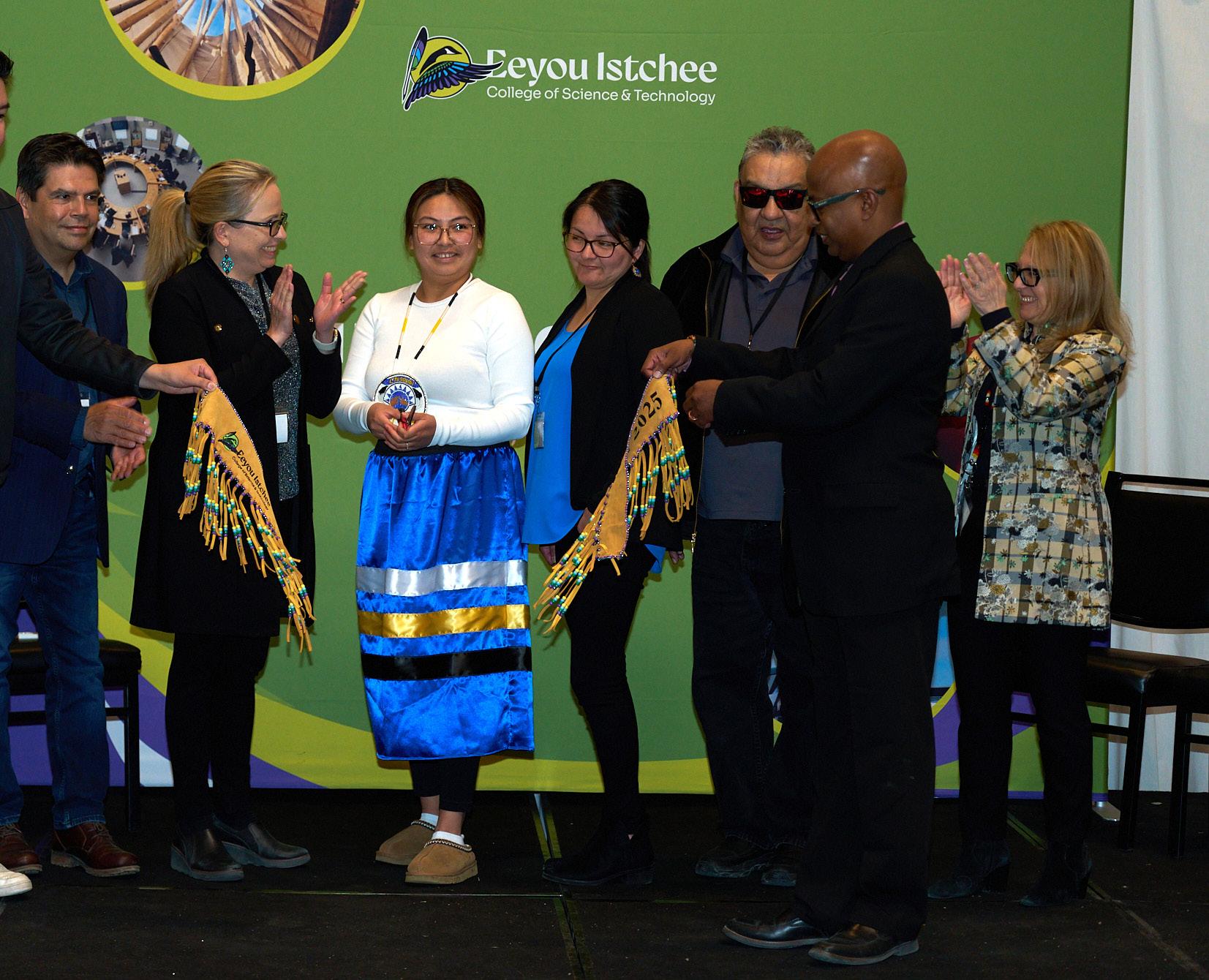
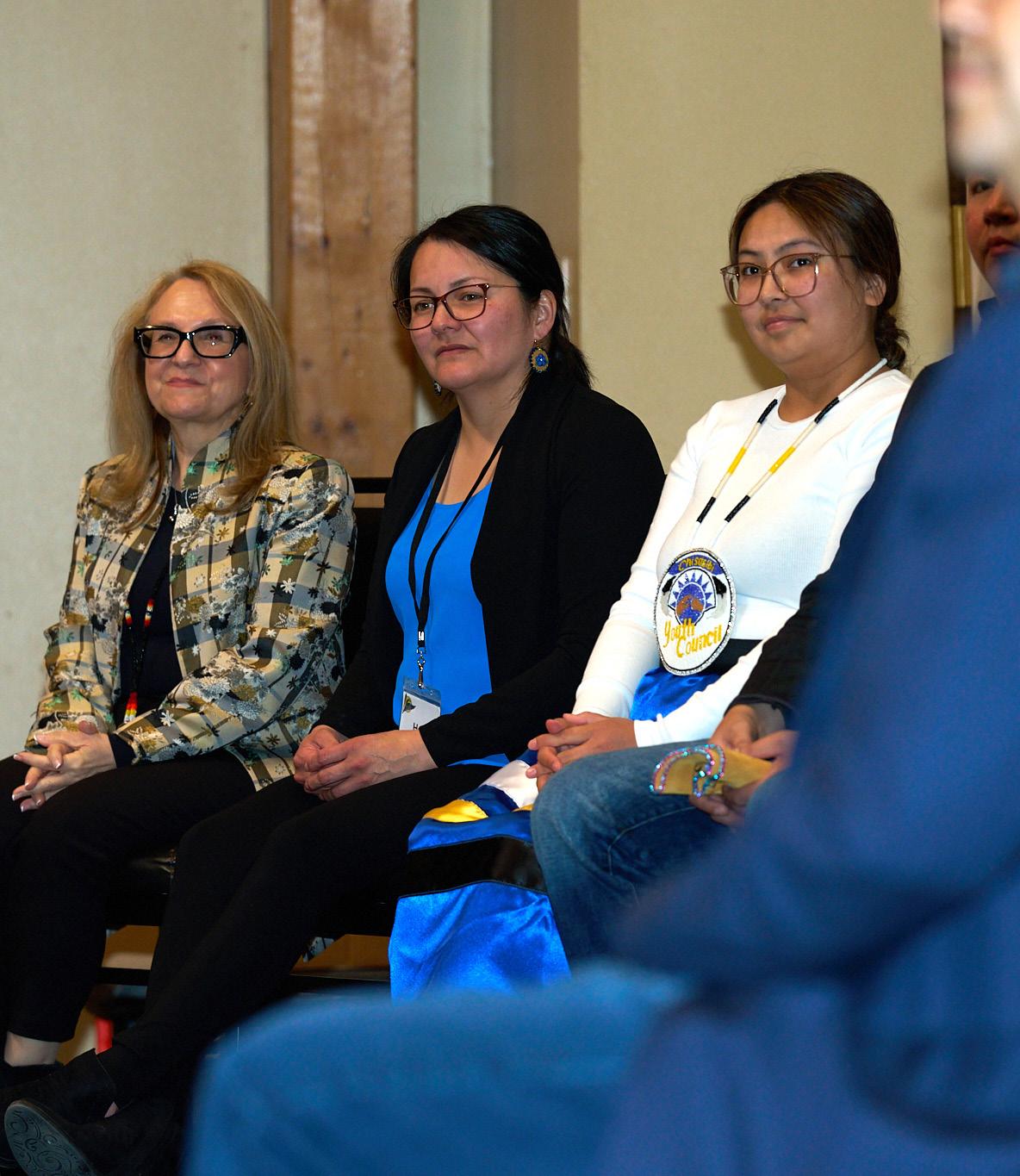
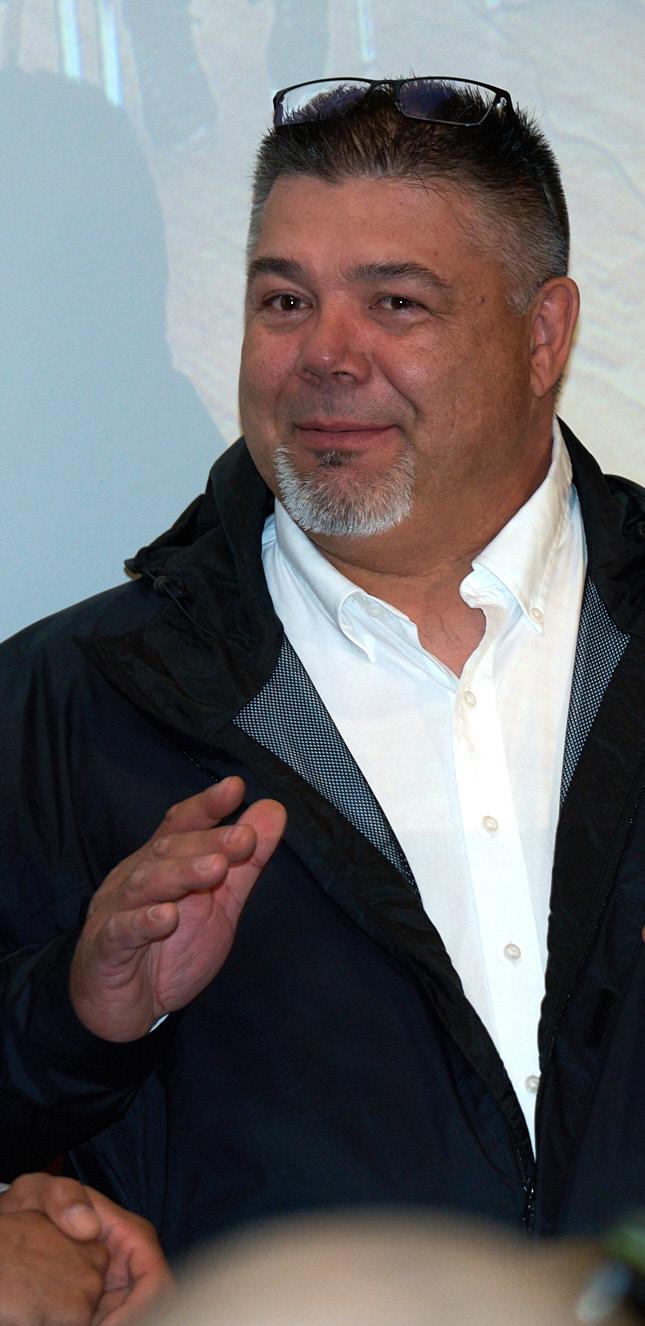
that you’re retired you have time to work on this initiative,” Sicilia told the Nation. “When I came in 2024, I took it from where they left off, validating the needs of the community and putting in proposals to the Ministry of Higher Education. Less than a year later, we’re up and running.”
Official approval of the school’s permits for delivering accredited courses is expected any day, but the college has been operating since January. About 70 people from the local co-op, radio, development group and regional government are currently enrolled in a certificate program in professional practice.
The college will soon offer six programs with staggered start dates leading to a diploma in College Studies (DCS) and an Attestation in College Studies (ACS). This fall, it will launch two – a springboard into STEM and an attestation in Indigenous business management and governance.
“It’s a really good thing for the Cree Nation to have a college way up north,” said Grand Chief Norman Wapachee. “You can still go out hunting in the heart of the territory. STEM (science, tech-
nology, engineering, math) is a big need for the Cree Nation. We need to prepare our youth to take on bigger roles – forest and mining engineers, architects.”
A range of non-credit professional development courses will also be offered this fall, helping employers to improve employees’ skill sets. They include Cree, English and Frenchlanguage training along with short courses in business essentials, operations management and building inclusive environments.
In 2026, there will be web/mobile development and computer networking programs; in 2027, full diploma programs in computer science technology, administration and management will be launched. Further programs will follow consultations with local employers to identify workforce needs.
The college’s initial focus on business management and technology is a response to the region’s employment needs. A regional hospital will soon open near the campus, an incentive to offer health and sciences courses.
“The community is the campus,” Sicilia observed. “You have all these wonderful conference rooms in var-
ious buildings, sports facilities, a lab for land-based education. We’re going to build classrooms, laboratories and offices in an actual physical building.”
Smart classrooms will be built later this year in the Mitchuap Building. Collaborative educational initiatives are planned with the Chisasibi Eeyou Resource and Research Institute (CERRI) in partnership with another research and development organization. CERRI marine biologist Dante Torrio said technical and communication skills provided by the college will be significant for the community.
Elder Jimmy R. Fireman has been meeting with students and staff to ensure that operations, teaching and learning are rooted in Cree culture. There’s also a position open for a Cree pedagogical and curriculum advisor.
“I’ve met so many Crees who have said I’m retiring in a few years and have so much knowledge to share,” Sicilia noted. “We have an initiative to provide training for Cree subject matter experts who have that knowledge but not that experience in teaching. The college will be a stage where they can share that with the community.”
Grand Chief
Land, Culture & Language
Preservation
Community Care & Collective Healing
Economic
Independence & Shared Prosperity
Governance &
Constitutional
Evolution
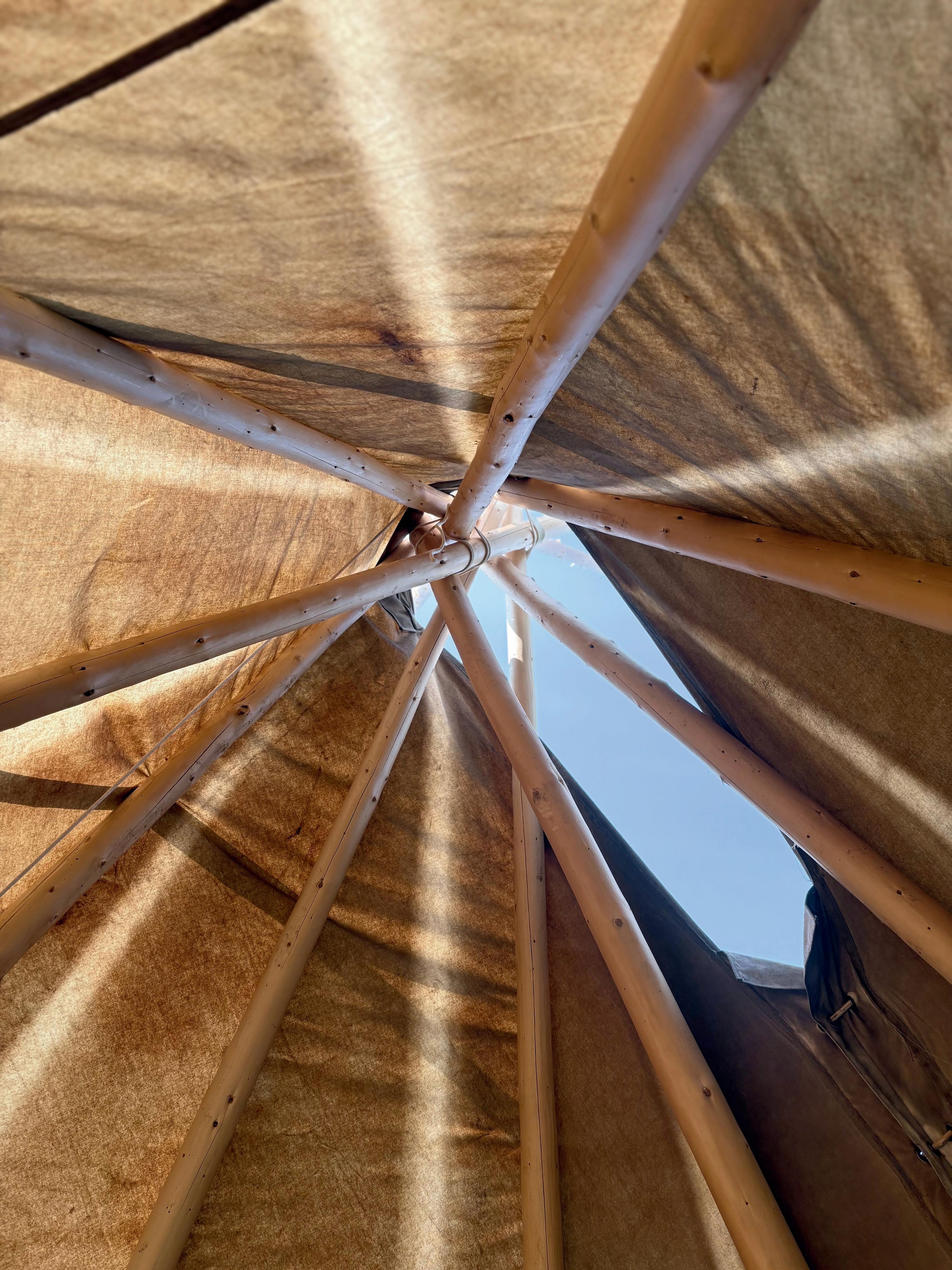






The 21st Conference of the Secretariat to the Cree Nation AbitibiTémiscamingue Economic Alliance brought together a cross-section of leaders and innovators in Amos June 11-12.
General Julie Martin said the conference explored three core topics: sustainable relationships, territories and energy.
“One of the things we realized quickly is that there is no line that can be drawn between those three differ-
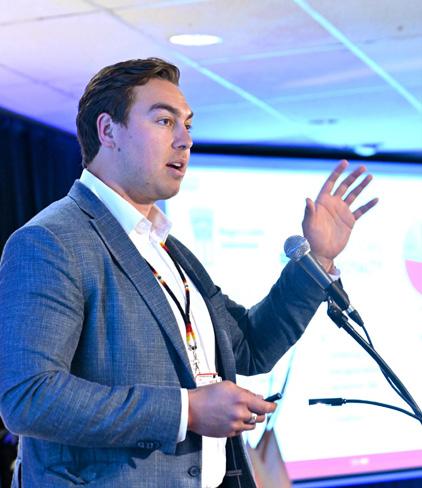
ent subjects,” Martin said. “Everything is intertwined, and it was impossible to speak about relationships without talking about territories and vice versa.”
She highlighted several of the conference’s key moments, that included the new Cree community of Washaw Sibi, a key exchange between SCNATEA President Ted Moses and outgoing Hydro-Québec CEO Michael Sabia, the presentation of the Cree Nation’s Climate Declaration, and a compel-

ouwahstore@gmail.com www.ouwahstore.com
(514) 588-3162 18 Fort-George Road

Business conference speakers urge leadership in resource projects by Natalia Fedosieieva
ling closing by Grand Chief Norman A. Wapachee.
Moses and Sabia discussed the future of energy in Eeyou Istchee, focusing on “replacement turbines in some of the installations to produce more electricity,” Martin said. “They also were talking about developing wind and solar farms.”
The event provided a platform for new speakers in Indigenous economic development, like Kody Penner, Vice President of Corporate Development at Nations Royalty, a mining firm based in British Columbia that offers investment capital in exchange for future mining revenues. Penner, from BC’s Tahltan First Nation, was recently named one of five Canadian young leaders in the Kakehashi Project for his innovative work.
“He showed how his company’s mission aligns with Indigenous values and long-term economic sustainability,” Martin said. “It had to do with building a better economy for everybody.”
Penner said the company creates long-term wealth by exchanging mining royalties for shares, reducing risk through a diversified portfolio.
“Instead of relying on just one mine for income, you rely on many mines across different regions,” he explained.
“If you’re a part shareholder of our company,
you own everything that it owns. That’s how the ownership structure works, so by pooling our revenue across Canada and in Quebec, we can create a diversified lower risk.”
Penner believes Indigenous communities belong at the forefront of Canada’s resource economy as owners, innovators and financial leaders.
Driven by a vision of economic sovereignty, Penner believes it is necessary to reach these agreements in a way that aligns First Nations and government interests towards a common goal.
“I wanted to help lead Indigenous people into the public markets,” Penner continues. “Before Nations Royalty, groups had to wait years and years to receive payments from these mines. Now, they get all that value upfront.”
For Penner, economic development is not just about receiving fair compensation as it is about building capacity, ownership and governance structures. The partnership potential is vast: from infrastructure and energy to logistics and environmental services.
“If we can pool our collective financial strengths, we can create something much more valuable than if we work in isolation,” he said.

Here’s another edition of the Nation’s puzzle page. Try your hand at Sudoku or Str8ts or our Crossword, or better yet, solve all three and send us a photo!* As always, the answers from last issue are here for you to check your work. Happy hunting.
PREVIOUS SOLUTION: Solution to Crossword:





I’ve been filled with a renewed sense of hope for the future through the work of filmmaker Jeronimo Kataquapit, who has made it his mission to highlight the connection that the people of Attawapiskat have to the land and its waters.
Jeronimo is the son of my cousin James Kataquapit and Monique Edwards. His grandparents Alex and Susan Kataquapit and Daniel and Elsie Edwards have always represented traditional Cree families who are deeply connected to the land.
Jeronimo, his brother Jonathan and their parents have been sharing a series of video logs on a recent trip from Attawapiskat west along the river to highlight the land they come from. It is part of a protest against the Ontario government’s Bill 5 and the federal government’s Bill C-5. You can follow their journey on Facebook at “Here We Stand - Call to Action”.
They hosted a series of gatherings in Attawapiskat to allow young people to paint and share a family flag to symbolize their participation. Jeronimo and his family plan to take the flags and post them on the Attawapiskat River to show how our people are still connected to the land.
They hope to travel as far as the Muketei River, 200km inland and connect with allies in Neskantaga First Nation, an Ojibway community on Attawapiskat Lake, 400km from James Bay. Their journey will
‘Here
by Xavier Kataquapit

be joined by supporters from other James Bay communities who will meet them at different points using floatplanes.
According to a Chiefs of Ontario statement, Bill 5 ignores “First Nations involvement, threatening sovereignty, land stewardship, and ongoing reconciliation efforts.”
Regarding Bill C-5, the Assembly of First Nations has “strong concerns over the rushed legislative process, lack of meaningful consultation, narrowly defined national interest that excludes First Nations priorities and perspectives, a failure to support First Nations priorities such as closing the infrastructure gap, and the broader implications for rights and jurisdiction.”
First Nation leaders and advocates are fighting back against both government power grabs, which threaten to override First Nation rights over the land they live on. Bill 5 allows the Ontario government to designate special economic zones that would allow companies to bypass regulations that protect the environment and ensure consultations with First Nations. Ontario is focusing its attention on the Ring of Fire mining zone west of James Bay and at the headwaters of the Attawapiskat River.
During their first video posting, the group stopped at the confluence of the Attawapiskat and Lawashi rivers at a place called Mahkehshekamik, or the Fox Channel. I was happy to see them there as
it was one of the places I had visited with James and family many years ago in the summer to fish and gather logs.
It felt good to see the pictures of the majestic red-hued water as the channel can narrow down to wild rapids between the rocks and then open up to wide expanses of water lined with pristine forests.
I felt happy when James and Monique spoke Ininewmoon (Cree) to share how they spotted moose, geese and even a set of giant pelicans. This is the magic of the land.
Every mile of this great river has a story of how it fed people, adventures and those who had been lost to the land. The river has seen centuries of travel by canoe, portages – and in winter –by dog sled, snowshoe and snowmobile to and from fishing areas, hunting camps, traplines, birthplaces and burial grounds.
20-year-old John Mercier
These lands are not just a place for resource developers to invade and tear apart. This land is our home and has been since the dawn of time. It is who we are as a people.
I was deeply moved by Jeronimo’s direct action to spend time on the land he and his family want to defend. The journey is only part of the protests against Bill 5 and Bill C-5 across the province and country.
Meegwetch to all who are standing up for the land.







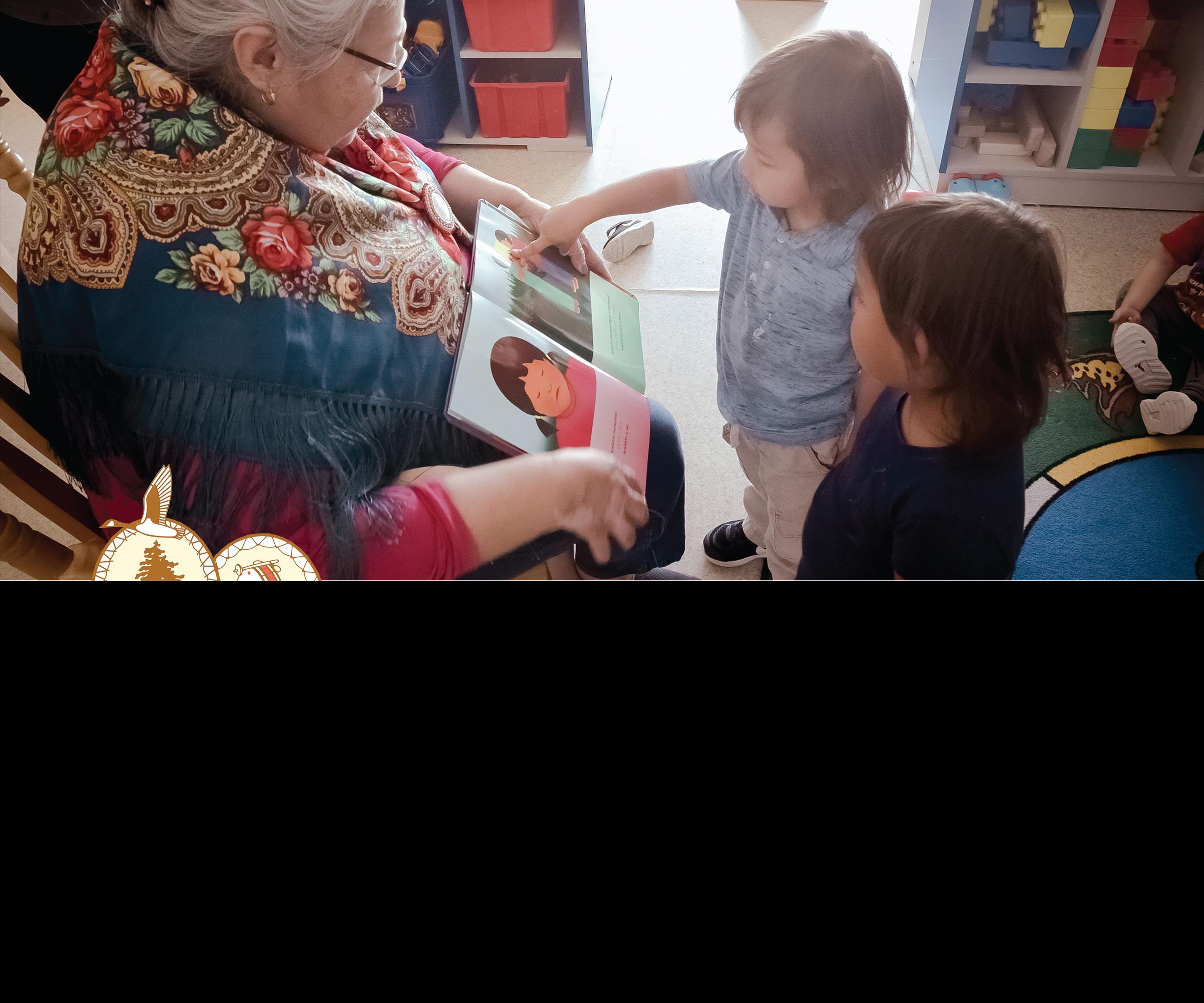


The Cree IELCC Fund is designed to fund projects/activities that foster the education, Cree culture and language, as well as health and wellbeing of children 0 to 6 and their families.
All projects and activities must also ensure that no children are left behind: activities must be accessible to all children, no matter their level of ability or special need.





























